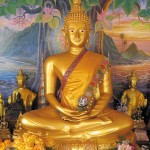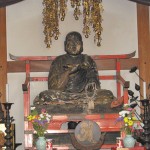In Hawaii, It’s Who’s Your Buddha?
Buddhism in Hawaii is not for everyone. The local temples may state openly that they welcome people from all backgrounds and hold no bias toward any race or ethnic group – and they may truly believe this – but anyone who has ever stepped inside one of the many local Buddhist temples will see things differently.
Japanese people and deities are worshipped at the altars at Japanese temples, Chinese personalities – historical and otherwise – are prayed to at Chinese temples, and Korean mythical figures are revered at Korean temples. The same holds true for the local Vietnamese, Thai, Tibetan and Laotian Buddhist temples.
- Laotian Shakyamuni Buddha. Photos by Jay Sakashita
- Traditional Japanese Kobo Daishi
Why the deep ethnic and cultural trappings for Buddhism in Hawaii? Nothing fails like success. Buddhism is the first world religion. It is not the oldest one, but it was the first to transcend ethnic, geographical and cultural boundaries. Indeed, it was so successful in this endeavor that in China, Buddhism became Chinese. The same happened in Myanmar, Thailand, Japan, Korea and elsewhere.
Everywhere, that is, except in Hawaii.
The forms of Buddhism transported to Hawaii from different places remain explicitly tied to their culture of origin. As a result, the Buddhist temples in Hawaii don’t observe the same traditions in the same way in the same place or at the same time. They are governed by different calendars and celebrate different holidays. Indeed, as illustrated in the accompanying photos, the Buddhist temples in Hawaii don’t even worship the same Buddha! The religion is fragmented.
Yet diversity can be a powerful tool, but there is still to appear a local Buddhist visionary who can take the principal message of the religion and repackage it in such a way that is attractive and understandable to everyone, regardless of ethnicity.
In short, there is no “Kama’aina Buddhism.” For local Buddhists this is unfortunate, as the conditions seem ripe for such a form of Buddhism to flourish.
Hawaii residents constantly are reminded by marketing campaigns to “buy local,” but when it comes to Buddhism in Hawaii, the temples have little to offer. There is no Kama’aina Buddhist entity to guide the local community as a whole on social issues or matters of concern. Instead, the strong culture-specific traits and ties fostered at the ethnic Buddhist temples make locals feel like strangers in their own land. It is difficult to be Japanese when you are not – or Chinese, Korean, Tibetan, Thai, Vietnamese or Laotian, for that matter. Little wonder, then, locals stay away. Their own cultural and ethnocentric views clash with Buddhism, and they dismiss the religion and its temples altogether as a result.
This may be regrettable, but for some of the Buddhist temples in Hawaii that also function as close-knit cultural centers, it is just fine. The trouble the local Buddhist temples have managing the dynamic between foreign culture and local people is nothing new, but it serves to benefit the missionary efforts of other faiths in Hawaii.
In the end, the ethnic Buddhist groups in Hawaii may unwittingly prove true the basic Buddhist teaching of impermanence by contributing to their own demise, and thus lay the foundation for the emergence of Kama’aina Buddhism in the process.
misfitspirit808@gmail.com





